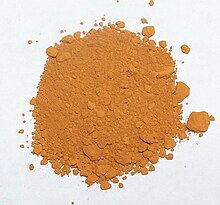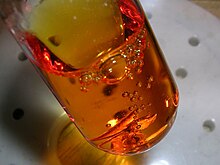Aqua regia
| Names | |
|---|---|
| IUPAC name
nitric acid hydrochloride
| |
| Other names
aqua regis, nitrohydrochloric acid
| |
| Identifiers | |
3D model (JSmol)
|
|
PubChem CID
|
|
CompTox Dashboard (EPA)
|
|
| |
| Properties | |
| HNO3+3 HCl | |
| Molar mass | 99.474 g/mol |
| Appearance | red, yellow or gold fuming liquid |
| Density | 1.01-1.21 g/cm3 |
| Melting point | -42 C |
| Boiling point | 108 C |
| miscible in water | |
| Vapor pressure | 21 mbar |
Except where otherwise noted, data are given for materials in their standard state (at 25 °C [77 °F], 100 kPa).
| |


Aqua regia (lit. "royal water"), aqua regis (lit. "king's water"), or nitro-hydrochloric acid is a highly-corrosive mixture of acids, a fuming yellow or red solution. The mixture is formed by freshly mixing concentrated nitric acid and hydrochloric acid,[1] usually in a volume ratio of 1:3. It was named so because it can dissolve the so-called royal or noble metals, gold and platinum. However, titanium, iridium, ruthenium, tantalum, osmium, rhodium and a few other metals are capable of withstanding its corrosive properties.[2]
Applications
Aqua regia is primarily used to produce chloroauric acid, the electrolyte in the Wohlwill process. This process is used for refining highest quality (99.999%) gold.
Aqua regia is also used in etching and in specific analytic procedures. It is also used in some laboratories to clean glassware of organic compounds and metal particles. This method is preferred over the "traditional" chromic acid bath for cleaning NMR tubes, because no traces of paramagnetic chromium can remain to later spoil acquired spectra.[3] While chromic acid baths are discouraged because of the high toxicity of chromium and the potential for explosions, aqua regia is itself very corrosive and has been implicated in several explosions due to mishandling.[4]
Due to the reaction between its components resulting in its decomposition, aqua regia quickly loses its effectiveness (yet remains a strong acid), so its components are usually only mixed immediately before use.
As with any chemical, ensure compliance with local and national regulations on safe disposal. Generally pouring any chemical, even neutralized acids, down the sink is to be avoided.
Chemistry
Dissolving gold

Aqua regia dissolves gold, though neither constituent acid will do so alone, because, in combination, each acid performs a different task. Nitric acid is a powerful oxidizer, which will actually dissolve a virtually undetectable amount of gold, forming gold ions (Au3+). The hydrochloric acid provides a ready supply of chloride ions (Cl−), which react with the gold ions to produce chloroaurate anions, also in solution. The reaction with hydrochloric acid is an equilibrium reaction which favors formation of chloroaurate anions (AuCl4−). This results in a removal of gold ions from solution and allows further oxidation of gold to take place. The gold dissolves to become chloroauric acid. In addition, gold may be dissolved by the free chlorine present in aqua regia. Appropriate equations are:
- Au (s) + 3 NO
3−
(aq) + 6 H+
(aq) → Au3+
(aq) + 3 NO
2 (g) + 3 H
2O (l) and
- Au3+
(aq) + 4 Cl−
(aq) → AuCl
4−
(aq).
The oxidation reaction can also be written with nitric oxide as the product rather than nitrogen dioxide:
- Au (s) + NO
3−
(aq) + 4 H+
(aq) → Au3+
(aq) + NO (g) + 2 H
2O (l).
Dissolving platinum

Similar equations can be written for platinum. As with gold, the oxidation reaction can be written with either nitric oxide or nitrogen dioxide as the nitrogen oxide product.
- Pt (s) + 4 NO3− (aq) + 8 H+ (aq) → Pt4+ (aq) + 4 NO2 (g) + 4 H2O (l)
- 3Pt (s) + 4 NO3− (aq) + 16 H+ (aq) → 3Pt4+ (aq) + 4 NO (g) + 8 H2O (l)
The oxidized platinum ion then reacts with chloride ions resulting in the chloroplatinate ion.
- Pt4+ (aq) + 6 Cl− (aq) → PtCl62− (aq)
Experimental evidence reveals that the reaction of platinum with aqua regia is considerably more complex. The initial reactions produce a mixture of chloroplatinous acid (H2PtCl4) and nitrosoplatinic chloride ((NO)2PtCl4). The nitrosoplatinic chloride is a solid product. If full dissolution of the platinum is desired, repeated extractions of the residual solids with concentrated hydrochloric acid must be performed.
- 2Pt (s) + 2HNO3 (aq) + 8 HCl (aq) → (NO)2PtCl4 (s) + H2PtCl4 (aq) + 4 H2O (l)
- (NO)2PtCl4 (s) + 2 HCl (aq) H2PtCl4 (aq) + 2 NOCl (g)
The chloroplatinous acid can be oxidized to chloroplatinic acid by saturating the solution with chlorine while heating.
- H2PtCl4 (aq) + Cl2 (g) → H2PtCl6 (aq)
Dissolving platinum solids in aqua regia was the mode of discovery for the most dense metals, iridium and osmium, both of which are found in platinum ore and will not be dissolved by the acid, instead collecting on the base of the vessel.
Reactions with other metals
Aqua regia reacts with tin to form tin(IV) chloride, containing tin in its highest oxidation state:
- 4 HCl + 2 HNO3 + Sn → SnCl4 + NO2 + NO + 3 H2O
Decomposition of aqua regia
Upon mixing of concentrated hydrochloric acid and concentrated nitric acid, chemical reactions occur. These reactions result in the volatile products nitrosyl chloride and chlorine as evidenced by the fuming nature and characteristic yellow color of aqua regia. As the volatile products escape from solution, the aqua regia loses its potency.
- HNO3 (aq) + 3 HCl (aq) → NOCl (g) + Cl2 (g) + 2 H2O (l)
Nitrosyl chloride can further decompose into nitric oxide and chlorine. This dissociation is equilibrium-limited. Therefore, in addition to nitrosyl chloride and chlorine, the fumes over aqua regia contain nitric oxide.
- 2 NOCl (g) → 2 NO (g) + Cl2 (g)
History
Aqua regia first appeared in the work of medieval European alchemist Pseudo-Geber, dating from the 14th century.[5] Antoine Lavoisier called it nitro-muriatic acid in 1789.[6]
When Germany invaded Denmark in World War II, Hungarian chemist George de Hevesy dissolved the gold Nobel Prizes of German physicists Max von Laue (1914) and James Franck (1925) in aqua regia to prevent the Nazis from confiscating them. The German government had prohibited Germans from accepting or keeping any Nobel Prize after jailed peace activist Carl von Ossietzky had received the Nobel Peace Prize in 1935. De Hevesy placed the resulting solution on a shelf in his laboratory at the Niels Bohr Institute. It was subsequently ignored by the Nazis who thought the jar—one of perhaps hundreds on the shelving—contained common chemicals. After the war, de Hevesy returned to find the solution undisturbed and precipitated the gold out of the acid. The gold was returned to the Royal Swedish Academy of Sciences and the Nobel Foundation. They re-cast the medals and again presented them to Laue and Franck.[7][8]
See also
References
- ^ The acid concentrations in water differ, and indicative values could be 65% for nitric acid and 35% for hydrochloric acid—that is, the actual NHO3:HCl volume ratio is less than 1:2,
- ^ Encyclopædia Britannica Online. "Aqua regia".
- ^ Hoffman, R., How to make an NMR sample, Hebrew University, 10 March 2005. Accessed 31 October 2006.
- ^ American Industrial Hygiene Association, Laboratory Safety Incidents: Explosions. Accessed 8 September 2010.
- ^ Encyclopædia Britannica 1911, Alchemy
- ^ Elements of Chemistry, p. 116
- ^ "Adventures in radioisotope research", George Hevesy
- ^ Birgitta Lemmel (2006). "The Nobel Prize Medals and the Medal for the Prize in Economics". The Nobel Foundation.

